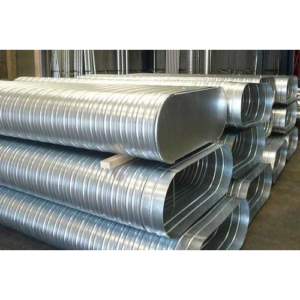There are three main types of ductwork categorize their rigidity:
Rigid Ductwork:
-
- This is the most common type of ductwork, known for its durability and ability to maintain its shape. It’s typically made from:
- Galvanized steel: The most widely used material due to its affordability, strength, and ease of fabrication.
- Aluminum: Less common but offers advantages like lighter weight and inherent corrosion resistance.
- Rigid ducts are ideal for:
- Long duct runs where maintaining shape is important.
- Applications requiring high-pressure air distribution.
- Situations where noise reduction is a priority, as rigid ducts can be insulated more effectively than flexible options.
- This is the most common type of ductwork, known for its durability and ability to maintain its shape. It’s typically made from:
Flexible Ductwork:
-
- This type of ductwork constructs from:
- Plastic or fabric materials with wire reinforcement.
- Can be easily bent and maneuvered around obstacles.
- Flexible ducts well-suite for:
- Short connections between rigid duct sections.
- Tight spaces where rigid ducts would be difficult to install.
- Connecting to registers or diffusers where final adjustments might needs.
- However, they have limitations:
- Not ideal for long runs due to potential pressure drops and noise concerns.
- May require additional support to prevent sagging and ensure proper airflow.
- Generally less durable than rigid ducts.
- This type of ductwork constructs from:

Semi-rigid Ductwork:
-
- This type offers a balance between rigidity and flexibility:
- Constructed from materials like:
- Insulated metal with a flexible inner core.
- Double-walled plastic with wire reinforcement.
- Constructed from materials like:
- Semi-rigid ducts often uses for:
- Situations requiring some flexibility for installation but also needing to maintain shape for efficient airflow.
- Connecting rigid duct sections where minor bends are necessary.
- Applications where noise reduction is a concern, as some semi-rigid options provide better sound dampening than flexible ducts.
- This type offers a balance between rigidity and flexibility:
Choosing the right type of ductwork depends on several factors, including:
- Application: Consider the purpose of the duct run (short connection, long run, tight space) and the required airflow characteristics.
- Space constraints: Rigid ducts require more space for installation compared to flexible options.
- Noise concerns: Rigid ducts can be better insulated for noise reduction, while some semi-rigid options offer similar benefits.
- Budget: Rigid ducts are generally the most affordable, while semi-rigid options might cost slightly more than flexible ducts.
Consulting with an HVAC professional recommends to determine the most suitable type of ductwork for your specific needs and system design.
Looking to install a commercial HVAC System or Duct work in your Business Area?
Contact Vipul Ac to learn about our HVAC Service
Call +91 9825636606 Today.
